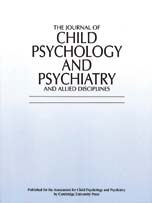Crossref Citations
This article has been cited by the following publications. This list is generated based on data provided by
Crossref.
Lease, A. Michele
and
Axelrod, Jennifer L.
2001.
Position in the Peer Group’s Perceived Organizational Structure:.
The Journal of Early Adolescence,
Vol. 21,
Issue. 4,
p.
377.
Donohue, Kathleen M
Perry, Kathryn E
and
Weinstein, Rhona S
2003.
Teachers' classroom practices and children's rejection by their peers.
Journal of Applied Developmental Psychology,
Vol. 24,
Issue. 1,
p.
91.
Maassen, Gerard H.
Steenbeek, Henderien
and
Geert, Paul van
2004.
STABILITY OF THREE METHODS FOR TWO-DIMENSIONAL SOCIOMETRIC STATUS DETERMINATION BASED ON THE PROCEDURE OF ASHER, SINGLETON, TINSLEY AND HYMEL.
Social Behavior and Personality: an international journal,
Vol. 32,
Issue. 6,
p.
535.
Frederickson, Norah
Warren, Laura
and
Turner, Jane
2005.
“Circle of Friends”—An Exploration of Impact Over Time.
Educational Psychology in Practice,
Vol. 21,
Issue. 3,
p.
197.
Campbell, Jonathan M.
Ferguson, Jane E.
Herzinger, Caitlin V.
Jackson, Jennie N.
and
Marino, Christine
2005.
Peers’ Attitudes Toward Autism Differ Across Sociometric Groups: An Exploratory Investigation.
Journal of Developmental and Physical Disabilities,
Vol. 17,
Issue. 3,
p.
281.
Zettergren, Peter
Bergman, Lars R.
and
Wångby, Margit
2006.
Girls’ stable peer status and their adulthood adjustment: A longitudinal study from age 10 to age 43.
International Journal of Behavioral Development,
Vol. 30,
Issue. 4,
p.
315.
Zettergren, Peter
2007.
Cluster Analysis in Sociometric Research: A Pattern-Oriented Approach to Identifying Temporally Stable Peer Status Groups of Girls.
The Journal of Early Adolescence,
Vol. 27,
Issue. 1,
p.
90.
Koster, Marloes
Nakken, Han
Pijl, Sip Jan
van Houten, Els J.
and
Lutje Spelberg, Henk C.
2008.
Assessing social participation of pupils with special needs in inclusive education: the construction of a teacher questionnaire.
Educational Research and Evaluation,
Vol. 14,
Issue. 5,
p.
395.
Lansford, Jennifer E.
Killeya-Jones, Ley A.
Miller, Shari
and
Costanzo, Philip R.
2009.
Early Adolescents’ Social Standing in Peer Groups: Behavioral Correlates of Stability and Change.
Journal of Youth and Adolescence,
Vol. 38,
Issue. 8,
p.
1084.
Frazier, Stacy L.
Atkins, Marc S.
Olson, Laura Hess
and
Lyon, Aaron R.
2009.
Same-Sex and Other-Sex Peer Reports: Unique Contributors to Understanding Children’s School Adjustment.
Journal of Psychopathology and Behavioral Assessment,
Vol. 31,
Issue. 3,
p.
152.
Avramidis, Elias
and
Wilde, Alison
2009.
Evaluating the social impacts of inclusion through a multi-method research design.
Education 3-13,
Vol. 37,
Issue. 4,
p.
323.
Jones, Alice P.
and
Frederickson, Norah
2010.
Multi-Informant Predictors of Social Inclusion for Students with Autism Spectrum Disorders Attending Mainstream School.
Journal of Autism and Developmental Disorders,
Vol. 40,
Issue. 9,
p.
1094.
Frederickson, Norah
Petrides, K.V.
and
Simmonds, Elizabeth
2012.
Trait emotional intelligence as a predictor of socioemotional outcomes in early adolescence.
Personality and Individual Differences,
Vol. 52,
Issue. 3,
p.
323.
Smith, H.
Polenik, K.
Nakasita, S.
and
Jones, A. P.
2012.
Profiling social, emotional and behavioural difficulties of children involved in direct and indirect bullying behaviours.
Emotional and Behavioural Difficulties,
Vol. 17,
Issue. 3-4,
p.
243.
Laws, Glynis
Bates, Geraldine
Feuerstein, Maike
Mason-Apps, Emily
and
White, Catherine
2012.
Peer acceptance of children with language and communication impairments in a mainstream primary school: Associations with type of language difficulty, problem behaviours and a change in placement organization.
Child Language Teaching and Therapy,
Vol. 28,
Issue. 1,
p.
73.
McMullen, Jake A.
Veermans, Koen
and
Laine, Kaarina
2014.
Tools for the classroom? An examination of existing sociometric methods for teacher use.
Scandinavian Journal of Educational Research,
Vol. 58,
Issue. 5,
p.
624.
Reed, Phil
and
Osborne, Lisa A.
2014.
Handbook of Early Intervention for Autism Spectrum Disorders.
p.
447.
Warren, Laura
Jones, Alice
and
Frederickson, Norah
2015.
Callous-unemotional interpersonal style in DSM-V: what does this mean for the UK SEBD population?.
Emotional and Behavioural Difficulties,
Vol. 20,
Issue. 3,
p.
317.
Finch, W. Holmes
2016.
Comparison of Multivariate Means across Groups with Ordinal Dependent Variables: A Monte Carlo Simulation Study.
Frontiers in Applied Mathematics and Statistics,
Vol. 2,
Issue. ,
García Bacete, Francisco J.
and
Cillessen, Antonius H. N.
2017.
An Adjusted Probability Method for the Identification of Sociometric Status in Classrooms.
Frontiers in Psychology,
Vol. 8,
Issue. ,

